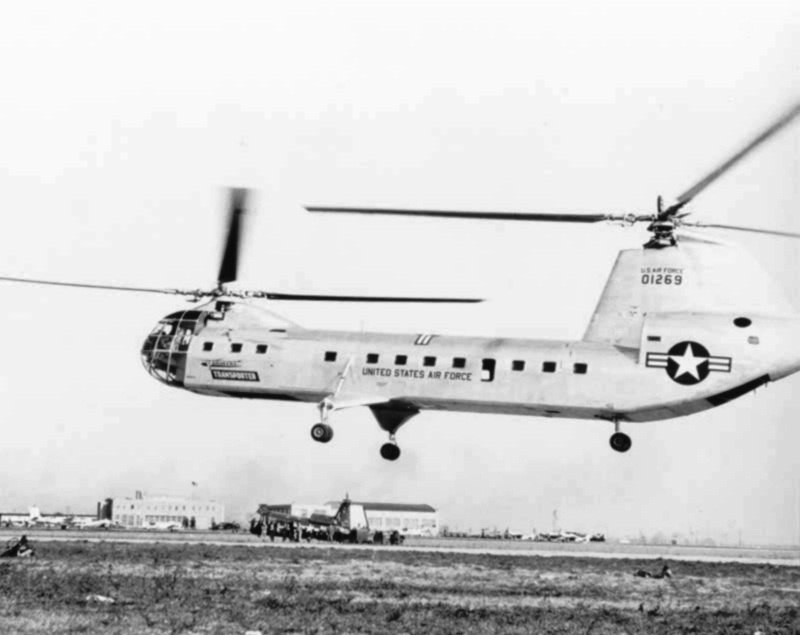Piasecki H-16 on:
[Wikipedia]
[Google]
[Amazon]
The Piasecki H-16 Transporter (company designation PV-15) was a tandem-rotor transport or rescue helicopter designed by
 ;XH-16/YH-16
: Powered by two Pratt & Whitney R-2180-E Twin Wasp E radial engines and room for 43 troops, one built later converted to a YH-16B.
;YH-16A
: Powered by two Allison T38-A-10 1,800 shp
;XH-16/YH-16
: Powered by two Pratt & Whitney R-2180-E Twin Wasp E radial engines and room for 43 troops, one built later converted to a YH-16B.
;YH-16A
: Powered by two Allison T38-A-10 1,800 shp

Piasecki H-16 page"Biggest Transport Helicopter Cruises 150 Miles Per Hour."
''Popular Mechanics'', January 1954, p. 119, bottom of page. {{USAF helicopters H-16 Piasecki H-16 1950s United States helicopters Tandem rotor helicopters Twin-turbine helicopters Military transport helicopters Cancelled military aircraft projects of the United States Aircraft first flown in 1953
Frank Piasecki
Frank Nicolas Piasecki ( ; ; October 24, 1919 – February 11, 2008) was an American engineer and helicopter aviation pioneer. Piasecki pioneered tandem rotor helicopter designs and created the compound helicopter concept of vectored thrust using ...
and built by Piasecki Helicopter
Piasecki Helicopter Corporation was a designer and manufacturer of helicopters located in Philadelphia and nearby Morton, Pennsylvania, in the late 1940s and the 1950s. Its founder, Frank Piasecki, was ousted from the company in 1956 and starte ...
. The prototypes were evaluated by the United States Air Force
The United States Air Force (USAF) is the Aerial warfare, air military branch, service branch of the United States Armed Forces, and is one of the eight uniformed services of the United States. Originally created on 1 August 1907, as a part ...
and Army
An army (from Old French ''armee'', itself derived from the Latin verb ''armāre'', meaning "to arm", and related to the Latin noun ''arma'', meaning "arms" or "weapons"), ground force or land force is a fighting force that fights primarily on ...
, but the crash of the second test aircraft led to cancelling the project.
Design and development
Given the company designation PV-15, the tandem-rotor helicopter was designed by company founder Frank Piasecki. The design was publicly shown for the first time on 15 September 1953 at thePhiladelphia airport
Philadelphia International Airport is the primary airport serving Philadelphia, Pennsylvania. The airport served 19.6 million passengers annually in 2021, making it the 21st busiest airport in the United States. The airport is located from t ...
.
Operational history
Crash
On 5 January 1956, the second YH-16 test aircraft crashed while returning to Philadelphia from a test flight over New Jersey.Piasecki Helicopter Corporation newsletter, January 1956 The cause of the crash was later determined to be the aft slip ring, which carried flight data from the instrumented rotor blades to the data recorders in the cabin. The slip ring bearings seized, and the resultant torque load severed the instrumentation standpipe inside the aft rotor shaft. A segment of this steel standpipe tilted over and came into contact with the interior of the aluminum rotor shaft, scribing a deepening groove into it. The rotor shaft eventually failed in flight, which in turn led to the aft blades and forward blades desynchronizing and colliding. The aircraft was a total loss; the two test pilots, Harold Peterson and George Callahan, were killed. This led to the cancellation not only of the YH-16, but also the planned 69-passenger YH-16B version.Variants
 ;XH-16/YH-16
: Powered by two Pratt & Whitney R-2180-E Twin Wasp E radial engines and room for 43 troops, one built later converted to a YH-16B.
;YH-16A
: Powered by two Allison T38-A-10 1,800 shp
;XH-16/YH-16
: Powered by two Pratt & Whitney R-2180-E Twin Wasp E radial engines and room for 43 troops, one built later converted to a YH-16B.
;YH-16A
: Powered by two Allison T38-A-10 1,800 shp turboshaft
A turboshaft engine is a form of gas turbine that is optimized to produce shaftpower rather than jet thrust. In concept, turboshaft engines are very similar to turbojets, with additional turbine expansion to extract heat energy from the exhaust ...
engines; previously designated XH-27.
;YH-16B
: Prototype XH-16A re-engined with two Allison T56-A-5 2,100 shp turboshaft engines.
Specifications (YH-16B)
See also
References
* *External links
Piasecki H-16 page
''Popular Mechanics'', January 1954, p. 119, bottom of page. {{USAF helicopters H-16 Piasecki H-16 1950s United States helicopters Tandem rotor helicopters Twin-turbine helicopters Military transport helicopters Cancelled military aircraft projects of the United States Aircraft first flown in 1953